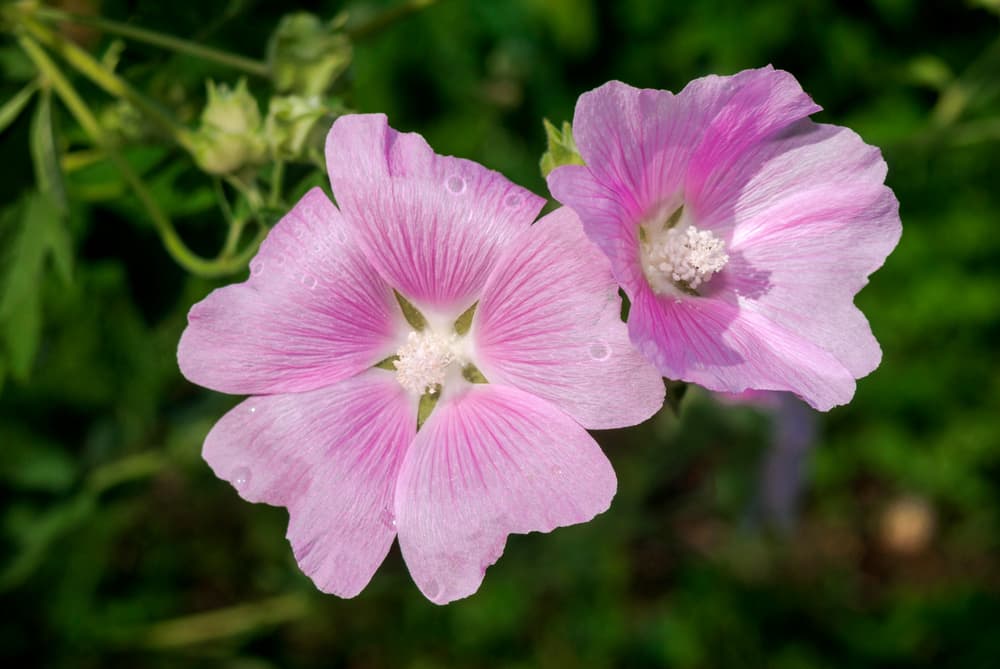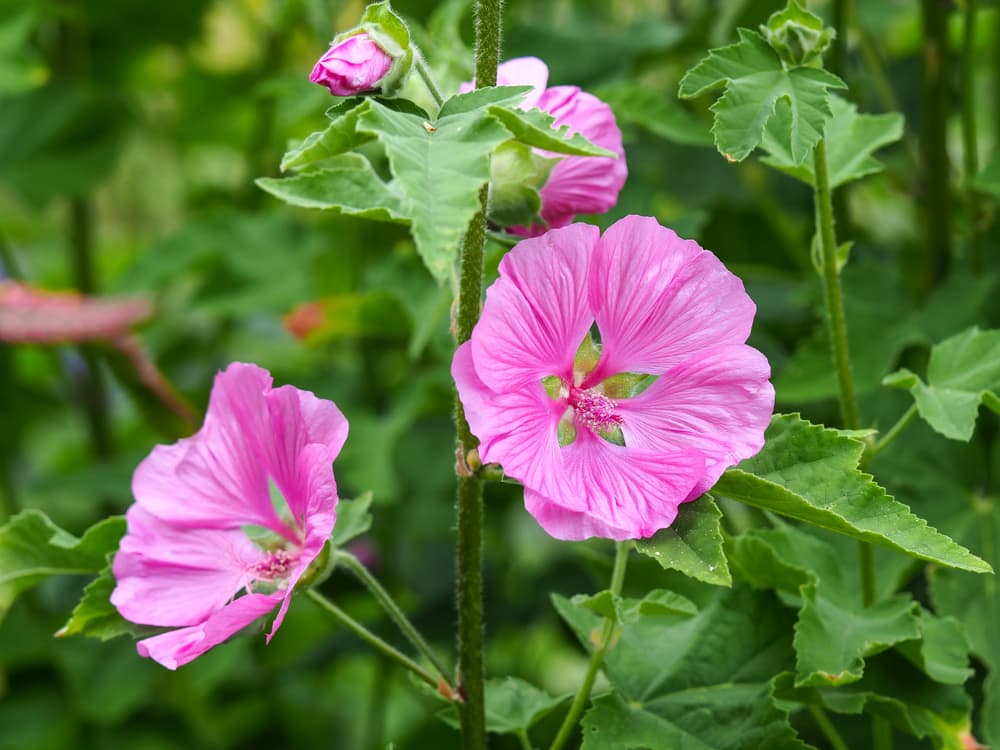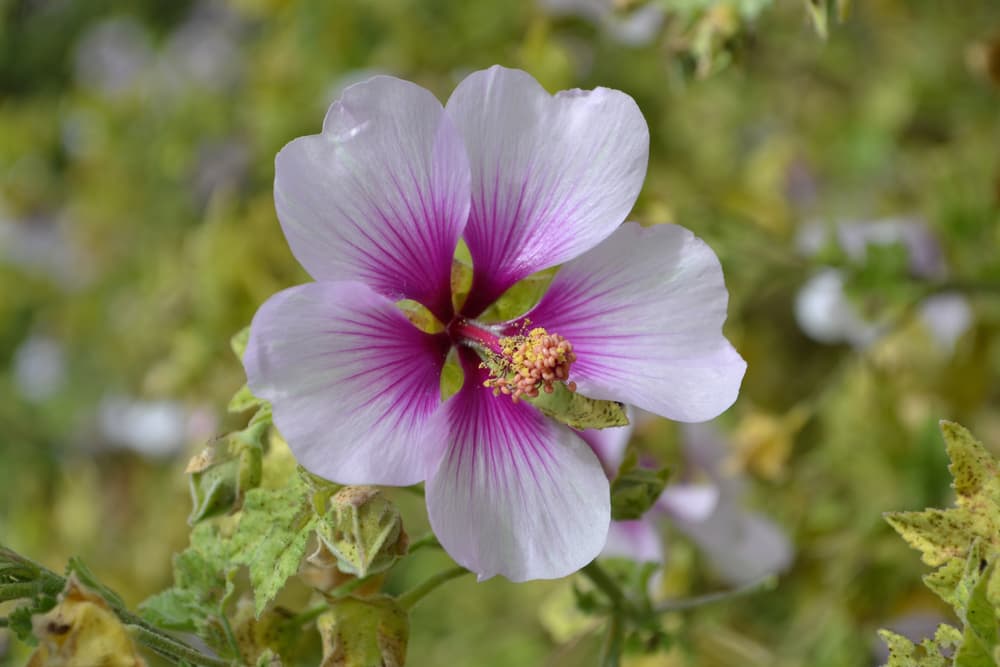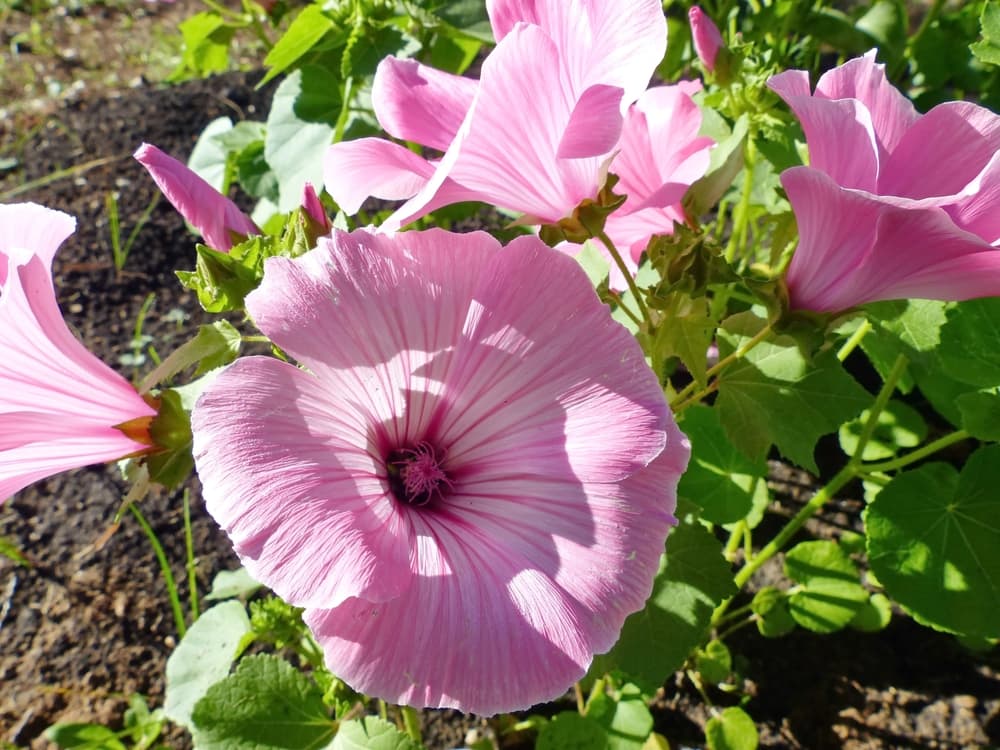PERENNIALS > LAVATERA
Chris is a gardening writer and nature enthusiast. He graduated from Oxford Brookes University in 2022 with an MA in Psychology. Chris works with the Leeds Green Action Society, helping their food cooperative by growing various fruit and vegetables on their two allotments in Hyde Park, Leeds.
Reviewed By COLIN SKELLY

Colin is a Horticulturist and Horticultural Consultant with experience in a range of practical and managerial roles across heritage, commercial and public horticulture. He holds the Royal Horticultural Society’s Master of Horticulture award and has a particular interest in horticultural ecology and naturalistic planting for habitat and climate resilience.
IN THIS GUIDE
LAVATERA GUIDES
Described as adding a romantic touch to your garden due to all those lovely pink, purple and white coloured blooms – Lavatera is a tall flower which is pretty easy for even the most basic gardeners to grow.
It is regularly likened to Hollyhocks – although there aren’t as many colours as such since Lavatera itself is mostly white, with shades of pink, purple and red.
There is no denying Lavatera looks great for the border of a garden.
But it’s also eye-catching in a large planter, thanks to its generous blooms (4-12cm in diameter) and the way they grow in clusters.
Overview
| Botanical Name | Lavatera / Malva |
| Common Name(s) | Tree Mallow |
| Plant Type | Perennial |
| Native Area | Macaronesia, North Africa, Europe, Central and South-Western Asia, Ethiopia, North America and Australia |
| Hardiness Rating | H5 (mostly) |
| Foliage | Long-stalked evergreen with grey-green leaves and stems |
| Flowers | Large funnel-shaped blooms |
| When To Sow | March, April, May |
| Flowering Months | June, July, August, September |
Sunlight
Preferred
Full Sun
Exposure
Sheltered
Size
Height
1 – 2.5M
Spread
0.5 – 1M
Bloom Time
June – September
Soil
Preferred
Most Soil Types (Not Heavy Clay)
Moisture
Well Drained
pH
Any
You will find the Annual version of Lavatera begins flowering around the middle of June and lasts all the way through until those white and frosty crisper days of autumn.
The genus of the flower is from the Malvaceae family, which is native to the likes of North Africa, Europe, Asia, the west side of North America and Australia – so it’s pretty prevalent around the world!1Family: Malvaceae. (n.d.). Native Plant Trust: Go Botany. Retrieved March 21, 2023, from https://gobotany.nativeplanttrust.org/family/malvaceae/

A commonly-used name for Lavatera amongst the gardening community is Tree Mallow.
But you’ll also find it referred to as Annual Mallow, Rose Mallow or Royal Mallow.
Lavatera Types
Lavatera has technically been subsumed into the genus Malva but is still widely known by its old names.2Malva Tourn. (n.d.). Plants of the World Online. Retrieved July 3, 2023, from https://powo.science.kew.org/taxon/urn:lsid:ipni.org:names:60436984-2#children
It can be broken down into annual and perennial varieties.
Annual Lavateras

One of the most popular of the annual variety of Lavateras is L. trimestris.
The rather funnel-shaped flowers from this plant range from white (‘Mont Blanc’) to light pink (‘Pink Beauty’), dark pink (‘Silver Cup’) and cherry pink (‘Ruby Regis’).
Some of the blooms also feature eye-catching darker veining, much of which is contrasting and grows to a deeper shade near the centre of the flower.
The blooms resemble those found on Hollyhocks (which is why it is always being mixed up with these by amateur gardeners) and can be up to three inches wide.
The actual plant tends to grow up to two feet tall.
Perennial Lavateras

The Perennial form of the Lavateras plant is the one you will find most often referred to as Tree Mallows.
These are shrub-like and fast-growing and are the forms of the plant that look great as borders.
They tend to be particularly colourful and prevalent in their second year of growth.
Some of the most popular forms of Lavateras that you are likely to encounter in gardens around the UK and Europe include:
L. thuringiaca

L. thuringiaca is the perennial form of the plant you are most likely to encounter, such is its popularity.
The blooms are a range of different pink shades and the shrubby plant will grow up to 1.8m before disappearing every winter.3Lavatera thuringiaca. (n.d.-b). Plants for a Future. Retrieved March 21, 2023, from https://pfaf.org/User/Plant.aspx?LatinName=Lavatera+thuringiaca
Lavatera x clementii ‘Barnsley’

L. x clementii ‘Barnsley’ can often be found in many large gardens.
Growing to 2m tall and producing hollyhock-like flowers from June until September, the blooms are white and red in the centre, eventually fading to pale pink as the summer progresses.
It is a fast-growing plant.
Lavatera ‘Barnsley Baby’

L. ‘Barnsley Baby’ tends to be a smaller (in every sense) version of the above ‘Barnsley’.
It looks similar, but only grows to a total height of 1m or so.4Lavatera × clementii “Barnsley Baby.” (n.d.). Royal Horticultural Society. Retrieved March 21, 2023, from https://www.rhs.org.uk/plants/201424/lavatera-x-clementii-barnsley-baby/details
This makes it an excellent flower to grow if your garden is rather space-compromised.
L. maritima

L. maritima can grow as high as 8 feet tall and can spread by as much as 12 feet.
Its blooms are white and pink while the stem looks like a grey to green shade.
An extremely hardy plant, it is ideal for gardens near the sea; where growing other more genteel types of flowers may be somewhat of a challenge.
“This is a great plant for coastal gardens where a taste for cottage garden-style plants can be fulfilled by L. maritima,” shares Master Horticulturist Colin Skelly.
“It is robust enough to be grown outside of a shelter belt and can even be grown as a low hedge.”
Colourful Combinations

It may not be as colourful as Hollyhocks in terms of variety, but the shades Lavatera does offer are stunning.
Many of the flowers also have their beautiful trademark striations of deeper tones.
The dark eyes in the centre of the flower can also prove extremely eye-catching.
In fact, one thing is absolutely guaranteed – regardless of where in your garden you plant, it will always be one of the first flowers to meet your eye.
Plant Care & Growing Tips
Easy to grow from seed and to care for as time goes on, Lavatera is pretty robust when it comes to coping with strong winds and poor soil.

Although it doesn’t usually produce its beautiful and abundant five-petalled flowers until its second year, when it does, it certainly makes up for the lack of blooms in Year One.
Butterflies and bees love this plant – which is a big plus since these benefit the flowers.
Lavatera also self-seeds so pretty much ensures its place in your garden year-after-year (even if the shrub itself tends to die out after around five years).

The perennial version requires quite a bit of space in the garden to allow it to spread easily without hitting any obstacles.
Height-wise you’re looking at from three to six feet.
Insects aren’t a particular problem for most types of Lavatera – but frosts can be, unless they are pruned in spring to get rid of any damaged parts of the plant.
Habitat & Growing Conditions
The type of soil Lavatera likes best is that which is well-drained or even soil which is generally considered too poor for many flowers to grow in.
It doesn’t need a lot of watering – only really if there hasn’t been rain for some time – you’ll be able to tell if it needs watering since the petals will start to fall off.

This plant doesn’t need fertiliser either, unless it’s during the summer and even then, only monthly in order to prevent it growing too many leaves.
Lavatera are particularly popular with gardeners who lie near the coast – that’s because salt simply isn’t a problem for this plant.
If it’s very cold though it’s a good idea to grow them beside a wall for added shelter.

In terms of light, Lavatera will flourish in the sun, but it’s fine in partial shade too.
However, being such a fast grower, the plant can flop if there is far too much shade.
Pruning regularly means the branches will grow strong and keep them from spreading too much.
Buying Lavatera
You can, of course, buy Lavatera from any reputable garden seller in the UK.
But, much more satisfying, is for you to grow the plant from a cutting from a friend.
FAQs
Can I Prune Lavatera In Autumn?
No, it’s best to prune in early spring.
How Do I Propagate Lavatera?
It’s self-propagating!

The plants can easily be grown from seed (their long root system doesn’t do well when transplanted).
Plant in spring around 18-24 inches apart and wait for them to germinate in up to 20 days.
How Tall Does Lavatera Grow?
It depends on the particular variety of Lavatera – some can grow to as high as eight feet.

Is My Lavatera Dead?
If the root system is damaged it may well be.
This can sometimes be caused by strong winds.
How Long Does Perennial Lavatera Last?
The typical plant will stay in your garden for around five years before finally dying off – but will probably have self-propagated by then anyhow!
References
- 1Family: Malvaceae. (n.d.). Native Plant Trust: Go Botany. Retrieved March 21, 2023, from https://gobotany.nativeplanttrust.org/family/malvaceae/
- 2Malva Tourn. (n.d.). Plants of the World Online. Retrieved July 3, 2023, from https://powo.science.kew.org/taxon/urn:lsid:ipni.org:names:60436984-2#children
- 3Lavatera thuringiaca. (n.d.-b). Plants for a Future. Retrieved March 21, 2023, from https://pfaf.org/User/Plant.aspx?LatinName=Lavatera+thuringiaca
- 4Lavatera × clementii “Barnsley Baby.” (n.d.). Royal Horticultural Society. Retrieved March 21, 2023, from https://www.rhs.org.uk/plants/201424/lavatera-x-clementii-barnsley-baby/details

